Comprehensive Report on Business Finance: Costing and Budgeting
VerifiedAdded on 2023/06/12
|13
|2656
|252
Report
AI Summary
This business finance report provides a detailed analysis of breakeven points, standard costing systems, and variance analysis. It explores the importance of contribution in decision-making and prepares profitability statements using both absorption and marginal costing methods. The report also demonstrates the significance of standard costing and variance analysis in controlling costs and enhancing efficiency. Furthermore, it includes the preparation of various types of budgets, such as direct material, direct labor, variable overhead, and fixed overhead expenditure budgets, highlighting their role in guiding expenses and ensuring financial performance aligns with organizational goals. This comprehensive analysis offers valuable insights into effective financial management and resource allocation.
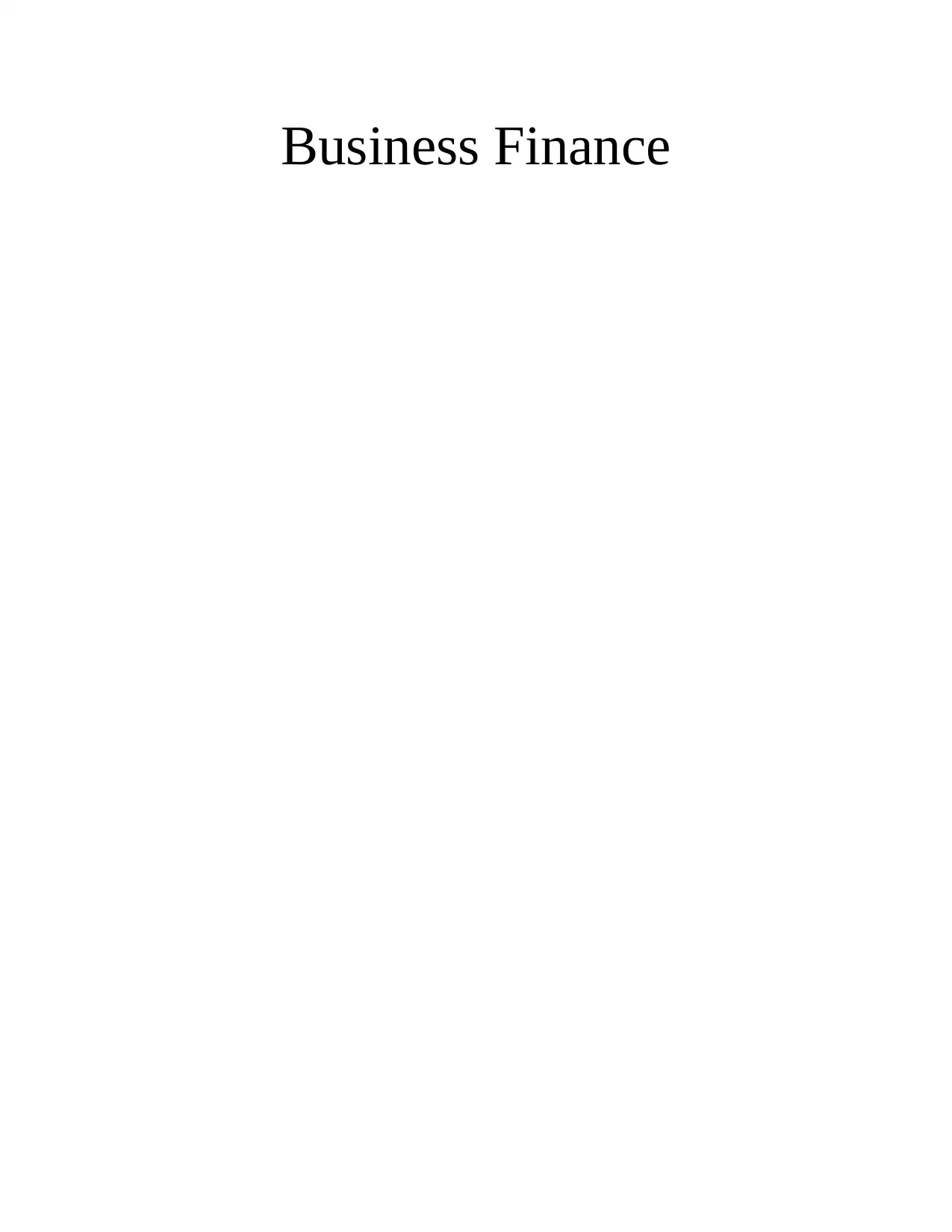
Business Finance
Paraphrase This Document
Need a fresh take? Get an instant paraphrase of this document with our AI Paraphraser
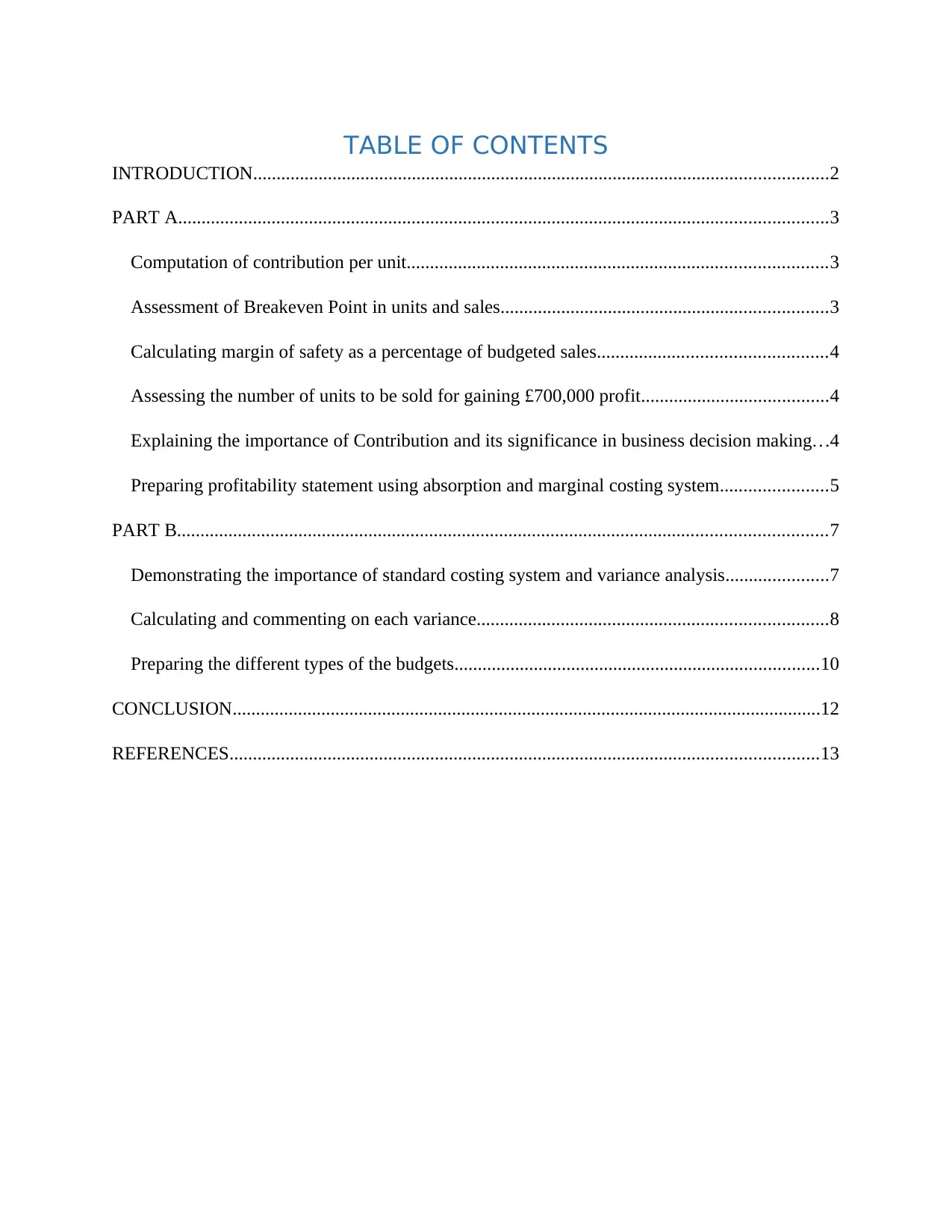
TABLE OF CONTENTS
INTRODUCTION...........................................................................................................................2
PART A...........................................................................................................................................3
Computation of contribution per unit..........................................................................................3
Assessment of Breakeven Point in units and sales......................................................................3
Calculating margin of safety as a percentage of budgeted sales.................................................4
Assessing the number of units to be sold for gaining £700,000 profit........................................4
Explaining the importance of Contribution and its significance in business decision making...4
Preparing profitability statement using absorption and marginal costing system.......................5
PART B...........................................................................................................................................7
Demonstrating the importance of standard costing system and variance analysis......................7
Calculating and commenting on each variance...........................................................................8
Preparing the different types of the budgets..............................................................................10
CONCLUSION..............................................................................................................................12
REFERENCES..............................................................................................................................13
INTRODUCTION...........................................................................................................................2
PART A...........................................................................................................................................3
Computation of contribution per unit..........................................................................................3
Assessment of Breakeven Point in units and sales......................................................................3
Calculating margin of safety as a percentage of budgeted sales.................................................4
Assessing the number of units to be sold for gaining £700,000 profit........................................4
Explaining the importance of Contribution and its significance in business decision making...4
Preparing profitability statement using absorption and marginal costing system.......................5
PART B...........................................................................................................................................7
Demonstrating the importance of standard costing system and variance analysis......................7
Calculating and commenting on each variance...........................................................................8
Preparing the different types of the budgets..............................................................................10
CONCLUSION..............................................................................................................................12
REFERENCES..............................................................................................................................13
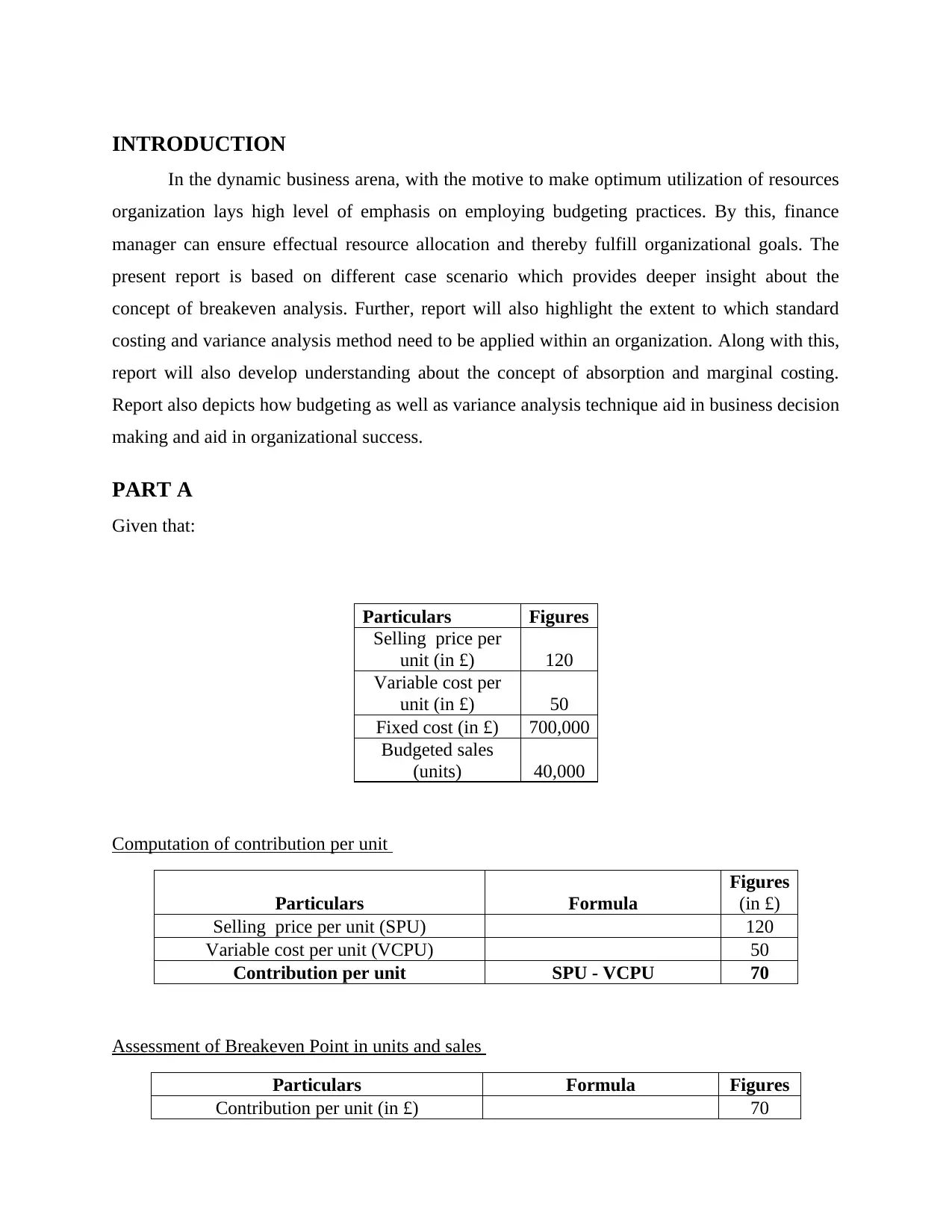
INTRODUCTION
In the dynamic business arena, with the motive to make optimum utilization of resources
organization lays high level of emphasis on employing budgeting practices. By this, finance
manager can ensure effectual resource allocation and thereby fulfill organizational goals. The
present report is based on different case scenario which provides deeper insight about the
concept of breakeven analysis. Further, report will also highlight the extent to which standard
costing and variance analysis method need to be applied within an organization. Along with this,
report will also develop understanding about the concept of absorption and marginal costing.
Report also depicts how budgeting as well as variance analysis technique aid in business decision
making and aid in organizational success.
PART A
Given that:
Particulars Figures
Selling price per
unit (in £) 120
Variable cost per
unit (in £) 50
Fixed cost (in £) 700,000
Budgeted sales
(units) 40,000
Computation of contribution per unit
Particulars Formula
Figures
(in £)
Selling price per unit (SPU) 120
Variable cost per unit (VCPU) 50
Contribution per unit SPU - VCPU 70
Assessment of Breakeven Point in units and sales
Particulars Formula Figures
Contribution per unit (in £) 70
In the dynamic business arena, with the motive to make optimum utilization of resources
organization lays high level of emphasis on employing budgeting practices. By this, finance
manager can ensure effectual resource allocation and thereby fulfill organizational goals. The
present report is based on different case scenario which provides deeper insight about the
concept of breakeven analysis. Further, report will also highlight the extent to which standard
costing and variance analysis method need to be applied within an organization. Along with this,
report will also develop understanding about the concept of absorption and marginal costing.
Report also depicts how budgeting as well as variance analysis technique aid in business decision
making and aid in organizational success.
PART A
Given that:
Particulars Figures
Selling price per
unit (in £) 120
Variable cost per
unit (in £) 50
Fixed cost (in £) 700,000
Budgeted sales
(units) 40,000
Computation of contribution per unit
Particulars Formula
Figures
(in £)
Selling price per unit (SPU) 120
Variable cost per unit (VCPU) 50
Contribution per unit SPU - VCPU 70
Assessment of Breakeven Point in units and sales
Particulars Formula Figures
Contribution per unit (in £) 70
⊘ This is a preview!⊘
Do you want full access?
Subscribe today to unlock all pages.

Trusted by 1+ million students worldwide
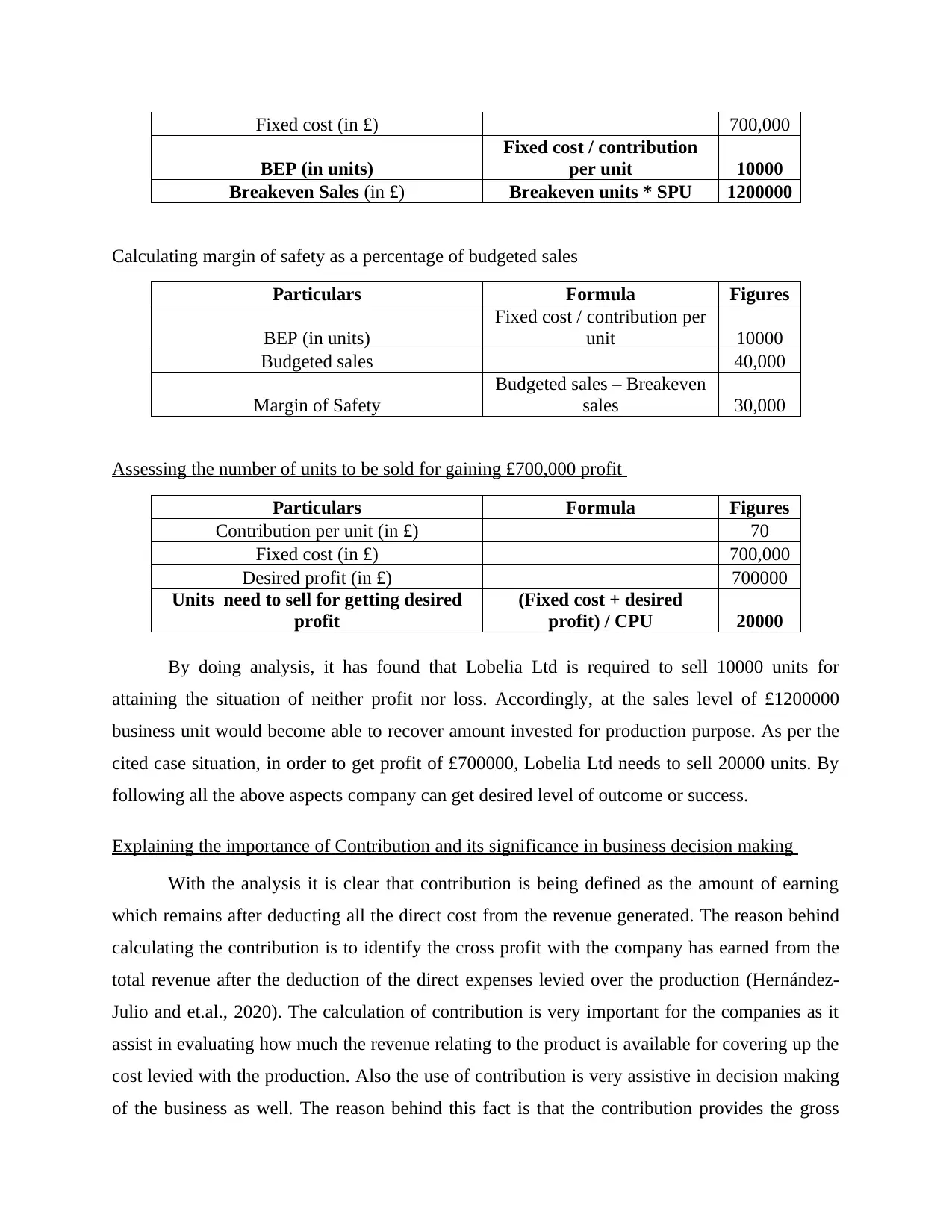
Fixed cost (in £) 700,000
BEP (in units)
Fixed cost / contribution
per unit 10000
Breakeven Sales (in £) Breakeven units * SPU 1200000
Calculating margin of safety as a percentage of budgeted sales
Particulars Formula Figures
BEP (in units)
Fixed cost / contribution per
unit 10000
Budgeted sales 40,000
Margin of Safety
Budgeted sales – Breakeven
sales 30,000
Assessing the number of units to be sold for gaining £700,000 profit
Particulars Formula Figures
Contribution per unit (in £) 70
Fixed cost (in £) 700,000
Desired profit (in £) 700000
Units need to sell for getting desired
profit
(Fixed cost + desired
profit) / CPU 20000
By doing analysis, it has found that Lobelia Ltd is required to sell 10000 units for
attaining the situation of neither profit nor loss. Accordingly, at the sales level of £1200000
business unit would become able to recover amount invested for production purpose. As per the
cited case situation, in order to get profit of £700000, Lobelia Ltd needs to sell 20000 units. By
following all the above aspects company can get desired level of outcome or success.
Explaining the importance of Contribution and its significance in business decision making
With the analysis it is clear that contribution is being defined as the amount of earning
which remains after deducting all the direct cost from the revenue generated. The reason behind
calculating the contribution is to identify the cross profit with the company has earned from the
total revenue after the deduction of the direct expenses levied over the production (Hernández-
Julio and et.al., 2020). The calculation of contribution is very important for the companies as it
assist in evaluating how much the revenue relating to the product is available for covering up the
cost levied with the production. Also the use of contribution is very assistive in decision making
of the business as well. The reason behind this fact is that the contribution provides the gross
BEP (in units)
Fixed cost / contribution
per unit 10000
Breakeven Sales (in £) Breakeven units * SPU 1200000
Calculating margin of safety as a percentage of budgeted sales
Particulars Formula Figures
BEP (in units)
Fixed cost / contribution per
unit 10000
Budgeted sales 40,000
Margin of Safety
Budgeted sales – Breakeven
sales 30,000
Assessing the number of units to be sold for gaining £700,000 profit
Particulars Formula Figures
Contribution per unit (in £) 70
Fixed cost (in £) 700,000
Desired profit (in £) 700000
Units need to sell for getting desired
profit
(Fixed cost + desired
profit) / CPU 20000
By doing analysis, it has found that Lobelia Ltd is required to sell 10000 units for
attaining the situation of neither profit nor loss. Accordingly, at the sales level of £1200000
business unit would become able to recover amount invested for production purpose. As per the
cited case situation, in order to get profit of £700000, Lobelia Ltd needs to sell 20000 units. By
following all the above aspects company can get desired level of outcome or success.
Explaining the importance of Contribution and its significance in business decision making
With the analysis it is clear that contribution is being defined as the amount of earning
which remains after deducting all the direct cost from the revenue generated. The reason behind
calculating the contribution is to identify the cross profit with the company has earned from the
total revenue after the deduction of the direct expenses levied over the production (Hernández-
Julio and et.al., 2020). The calculation of contribution is very important for the companies as it
assist in evaluating how much the revenue relating to the product is available for covering up the
cost levied with the production. Also the use of contribution is very assistive in decision making
of the business as well. The reason behind this fact is that the contribution provides the gross
Paraphrase This Document
Need a fresh take? Get an instant paraphrase of this document with our AI Paraphraser
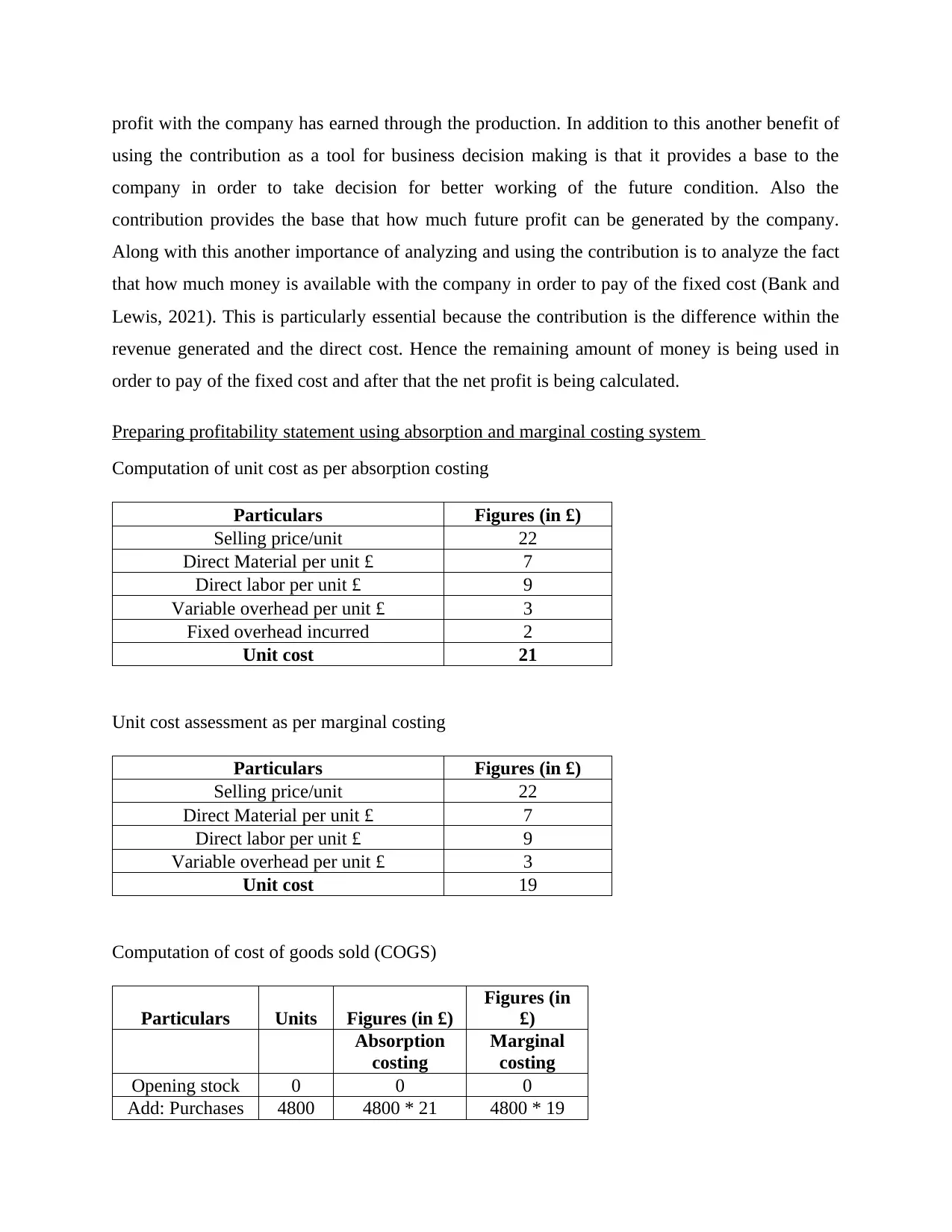
profit with the company has earned through the production. In addition to this another benefit of
using the contribution as a tool for business decision making is that it provides a base to the
company in order to take decision for better working of the future condition. Also the
contribution provides the base that how much future profit can be generated by the company.
Along with this another importance of analyzing and using the contribution is to analyze the fact
that how much money is available with the company in order to pay of the fixed cost (Bank and
Lewis, 2021). This is particularly essential because the contribution is the difference within the
revenue generated and the direct cost. Hence the remaining amount of money is being used in
order to pay of the fixed cost and after that the net profit is being calculated.
Preparing profitability statement using absorption and marginal costing system
Computation of unit cost as per absorption costing
Particulars Figures (in £)
Selling price/unit 22
Direct Material per unit £ 7
Direct labor per unit £ 9
Variable overhead per unit £ 3
Fixed overhead incurred 2
Unit cost 21
Unit cost assessment as per marginal costing
Particulars Figures (in £)
Selling price/unit 22
Direct Material per unit £ 7
Direct labor per unit £ 9
Variable overhead per unit £ 3
Unit cost 19
Computation of cost of goods sold (COGS)
Particulars Units Figures (in £)
Figures (in
£)
Absorption
costing
Marginal
costing
Opening stock 0 0 0
Add: Purchases 4800 4800 * 21 4800 * 19
using the contribution as a tool for business decision making is that it provides a base to the
company in order to take decision for better working of the future condition. Also the
contribution provides the base that how much future profit can be generated by the company.
Along with this another importance of analyzing and using the contribution is to analyze the fact
that how much money is available with the company in order to pay of the fixed cost (Bank and
Lewis, 2021). This is particularly essential because the contribution is the difference within the
revenue generated and the direct cost. Hence the remaining amount of money is being used in
order to pay of the fixed cost and after that the net profit is being calculated.
Preparing profitability statement using absorption and marginal costing system
Computation of unit cost as per absorption costing
Particulars Figures (in £)
Selling price/unit 22
Direct Material per unit £ 7
Direct labor per unit £ 9
Variable overhead per unit £ 3
Fixed overhead incurred 2
Unit cost 21
Unit cost assessment as per marginal costing
Particulars Figures (in £)
Selling price/unit 22
Direct Material per unit £ 7
Direct labor per unit £ 9
Variable overhead per unit £ 3
Unit cost 19
Computation of cost of goods sold (COGS)
Particulars Units Figures (in £)
Figures (in
£)
Absorption
costing
Marginal
costing
Opening stock 0 0 0
Add: Purchases 4800 4800 * 21 4800 * 19
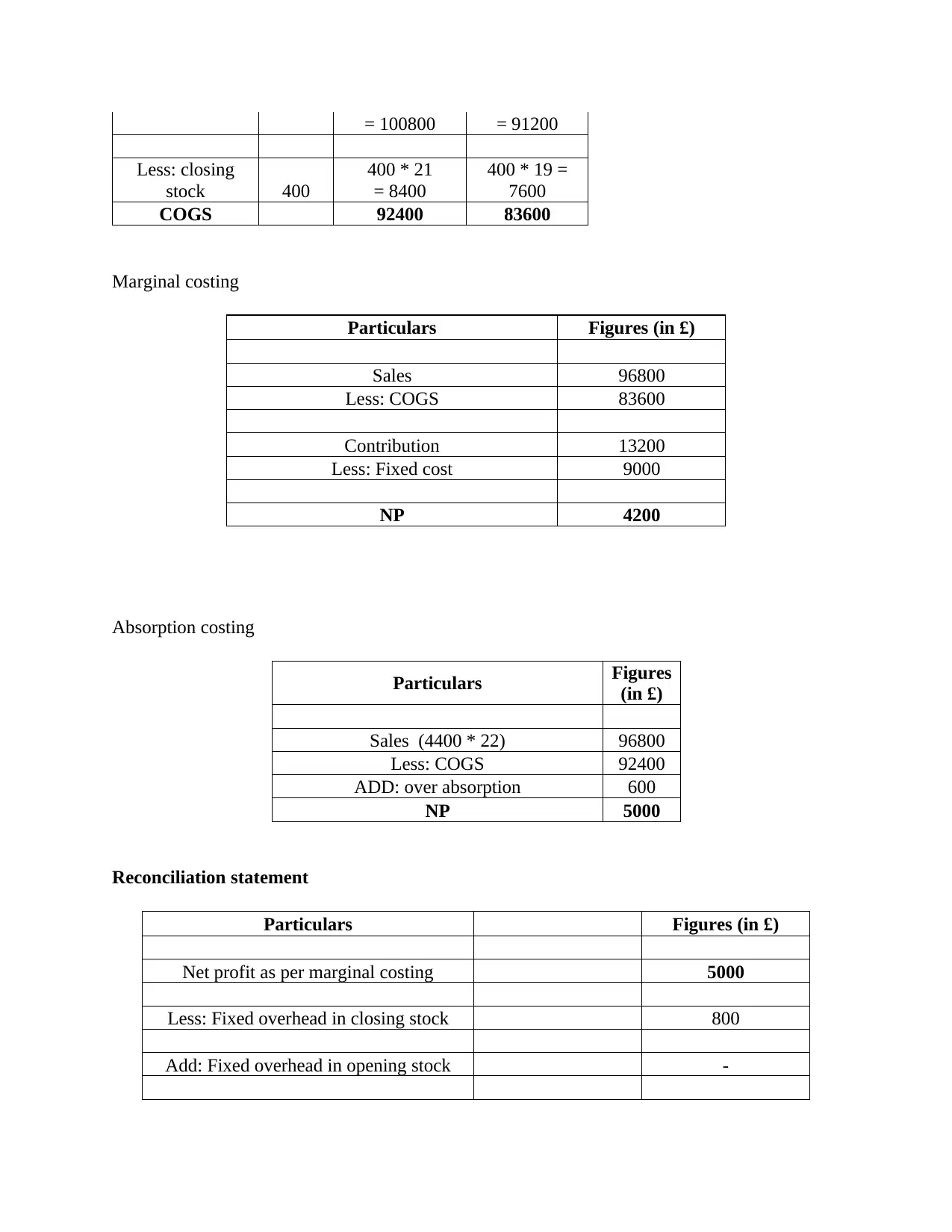
= 100800 = 91200
Less: closing
stock 400
400 * 21
= 8400
400 * 19 =
7600
COGS 92400 83600
Marginal costing
Particulars Figures (in £)
Sales 96800
Less: COGS 83600
Contribution 13200
Less: Fixed cost 9000
NP 4200
Absorption costing
Particulars Figures
(in £)
Sales (4400 * 22) 96800
Less: COGS 92400
ADD: over absorption 600
NP 5000
Reconciliation statement
Particulars Figures (in £)
Net profit as per marginal costing 5000
Less: Fixed overhead in closing stock 800
Add: Fixed overhead in opening stock -
Less: closing
stock 400
400 * 21
= 8400
400 * 19 =
7600
COGS 92400 83600
Marginal costing
Particulars Figures (in £)
Sales 96800
Less: COGS 83600
Contribution 13200
Less: Fixed cost 9000
NP 4200
Absorption costing
Particulars Figures
(in £)
Sales (4400 * 22) 96800
Less: COGS 92400
ADD: over absorption 600
NP 5000
Reconciliation statement
Particulars Figures (in £)
Net profit as per marginal costing 5000
Less: Fixed overhead in closing stock 800
Add: Fixed overhead in opening stock -
⊘ This is a preview!⊘
Do you want full access?
Subscribe today to unlock all pages.

Trusted by 1+ million students worldwide
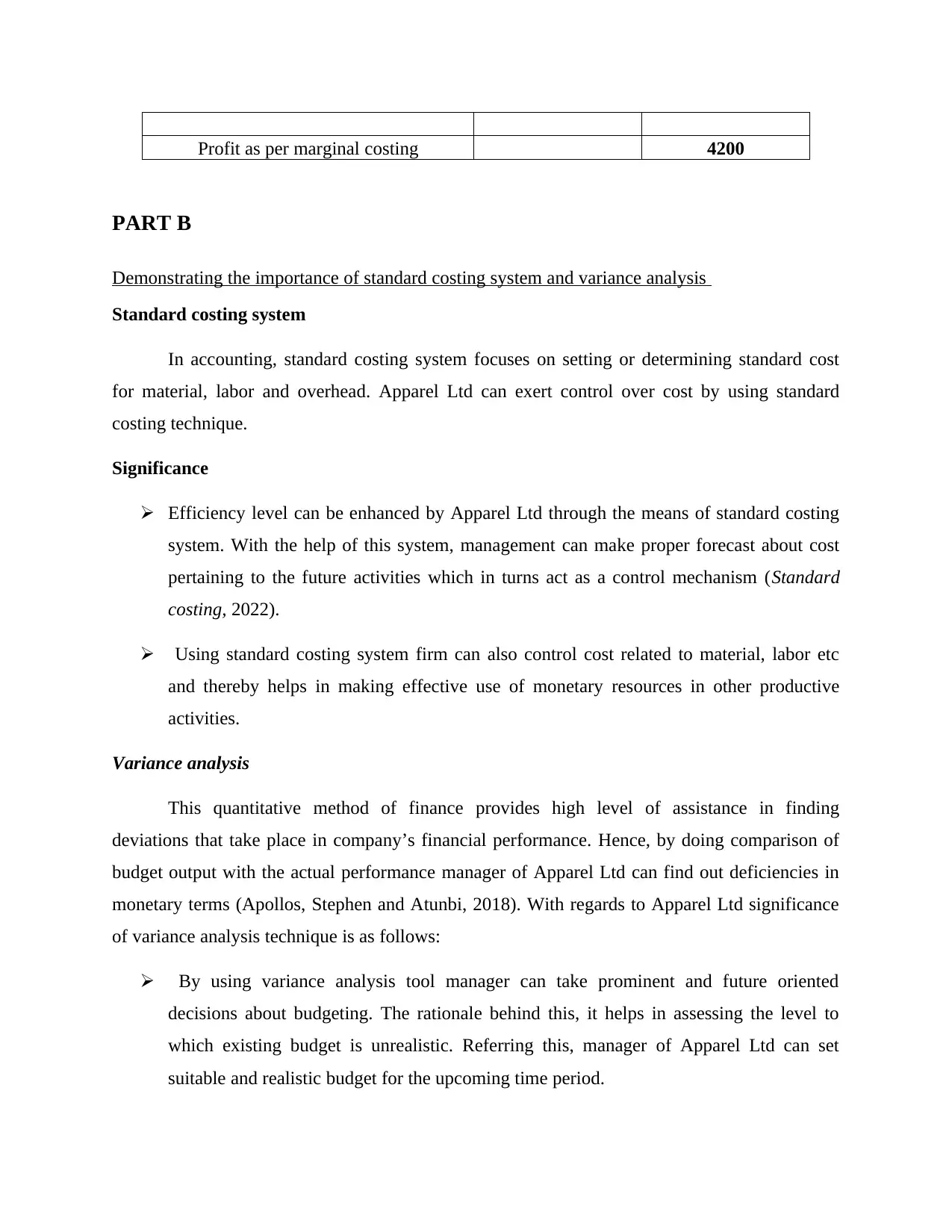
Profit as per marginal costing 4200
PART B
Demonstrating the importance of standard costing system and variance analysis
Standard costing system
In accounting, standard costing system focuses on setting or determining standard cost
for material, labor and overhead. Apparel Ltd can exert control over cost by using standard
costing technique.
Significance
Efficiency level can be enhanced by Apparel Ltd through the means of standard costing
system. With the help of this system, management can make proper forecast about cost
pertaining to the future activities which in turns act as a control mechanism (Standard
costing, 2022).
Using standard costing system firm can also control cost related to material, labor etc
and thereby helps in making effective use of monetary resources in other productive
activities.
Variance analysis
This quantitative method of finance provides high level of assistance in finding
deviations that take place in company’s financial performance. Hence, by doing comparison of
budget output with the actual performance manager of Apparel Ltd can find out deficiencies in
monetary terms (Apollos, Stephen and Atunbi, 2018). With regards to Apparel Ltd significance
of variance analysis technique is as follows:
By using variance analysis tool manager can take prominent and future oriented
decisions about budgeting. The rationale behind this, it helps in assessing the level to
which existing budget is unrealistic. Referring this, manager of Apparel Ltd can set
suitable and realistic budget for the upcoming time period.
PART B
Demonstrating the importance of standard costing system and variance analysis
Standard costing system
In accounting, standard costing system focuses on setting or determining standard cost
for material, labor and overhead. Apparel Ltd can exert control over cost by using standard
costing technique.
Significance
Efficiency level can be enhanced by Apparel Ltd through the means of standard costing
system. With the help of this system, management can make proper forecast about cost
pertaining to the future activities which in turns act as a control mechanism (Standard
costing, 2022).
Using standard costing system firm can also control cost related to material, labor etc
and thereby helps in making effective use of monetary resources in other productive
activities.
Variance analysis
This quantitative method of finance provides high level of assistance in finding
deviations that take place in company’s financial performance. Hence, by doing comparison of
budget output with the actual performance manager of Apparel Ltd can find out deficiencies in
monetary terms (Apollos, Stephen and Atunbi, 2018). With regards to Apparel Ltd significance
of variance analysis technique is as follows:
By using variance analysis tool manager can take prominent and future oriented
decisions about budgeting. The rationale behind this, it helps in assessing the level to
which existing budget is unrealistic. Referring this, manager of Apparel Ltd can set
suitable and realistic budget for the upcoming time period.
Paraphrase This Document
Need a fresh take? Get an instant paraphrase of this document with our AI Paraphraser
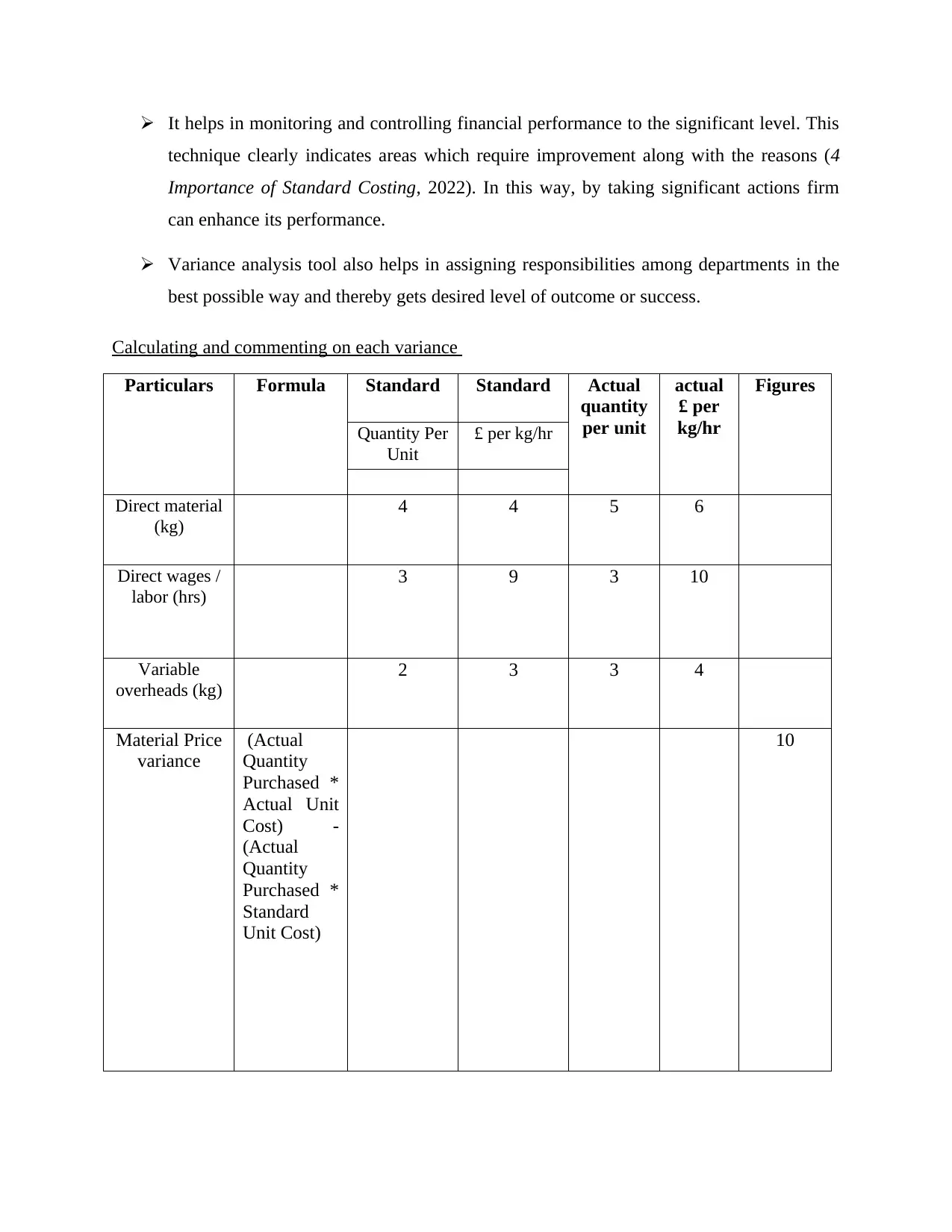
It helps in monitoring and controlling financial performance to the significant level. This
technique clearly indicates areas which require improvement along with the reasons (4
Importance of Standard Costing, 2022). In this way, by taking significant actions firm
can enhance its performance.
Variance analysis tool also helps in assigning responsibilities among departments in the
best possible way and thereby gets desired level of outcome or success.
Calculating and commenting on each variance
Particulars Formula Standard Standard Actual
quantity
per unit
actual
£ per
kg/hr
Figures
Quantity Per
Unit
£ per kg/hr
Direct material
(kg)
4 4 5 6
Direct wages /
labor (hrs)
3 9 3 10
Variable
overheads (kg)
2 3 3 4
Material Price
variance
(Actual
Quantity
Purchased *
Actual Unit
Cost) -
(Actual
Quantity
Purchased *
Standard
Unit Cost)
10
technique clearly indicates areas which require improvement along with the reasons (4
Importance of Standard Costing, 2022). In this way, by taking significant actions firm
can enhance its performance.
Variance analysis tool also helps in assigning responsibilities among departments in the
best possible way and thereby gets desired level of outcome or success.
Calculating and commenting on each variance
Particulars Formula Standard Standard Actual
quantity
per unit
actual
£ per
kg/hr
Figures
Quantity Per
Unit
£ per kg/hr
Direct material
(kg)
4 4 5 6
Direct wages /
labor (hrs)
3 9 3 10
Variable
overheads (kg)
2 3 3 4
Material Price
variance
(Actual
Quantity
Purchased *
Actual Unit
Cost) -
(Actual
Quantity
Purchased *
Standard
Unit Cost)
10

(Standard
quantity of
material –
Actual
quantity
used) × SPU
of material
-4
Material
Usage
variance
(Actual rate -
Standard
rate) x
Actual hours
worked
3
Labor Rate
variance
(Actual
hours -
Standard
hours) x
Standard rate
0
Labor
Efficiency
variance
Actual fixed
overhead -
Budgeted
fixed
overhead
-5000
Fixed
Overhead
Expenditure
variance
For the company to be successful it is very essential that proper variants analysis is being
undertaken for stop the variance analysis is a tool which August company in finding the
deviation within the budgeted and the actual performance. With the help of the material price
variance it is clear that the variance is favorable. This favorable variance implies that the actual
performance is better than the budgeted performance (Kraemer-Eis and et.al., 2019). Hence this
simply means that currently the company is performing well as expected. Further with help of
the material usage variants it is clear that the variance is adverse that is negative. This simply
quantity of
material –
Actual
quantity
used) × SPU
of material
-4
Material
Usage
variance
(Actual rate -
Standard
rate) x
Actual hours
worked
3
Labor Rate
variance
(Actual
hours -
Standard
hours) x
Standard rate
0
Labor
Efficiency
variance
Actual fixed
overhead -
Budgeted
fixed
overhead
-5000
Fixed
Overhead
Expenditure
variance
For the company to be successful it is very essential that proper variants analysis is being
undertaken for stop the variance analysis is a tool which August company in finding the
deviation within the budgeted and the actual performance. With the help of the material price
variance it is clear that the variance is favorable. This favorable variance implies that the actual
performance is better than the budgeted performance (Kraemer-Eis and et.al., 2019). Hence this
simply means that currently the company is performing well as expected. Further with help of
the material usage variants it is clear that the variance is adverse that is negative. This simply
⊘ This is a preview!⊘
Do you want full access?
Subscribe today to unlock all pages.

Trusted by 1+ million students worldwide
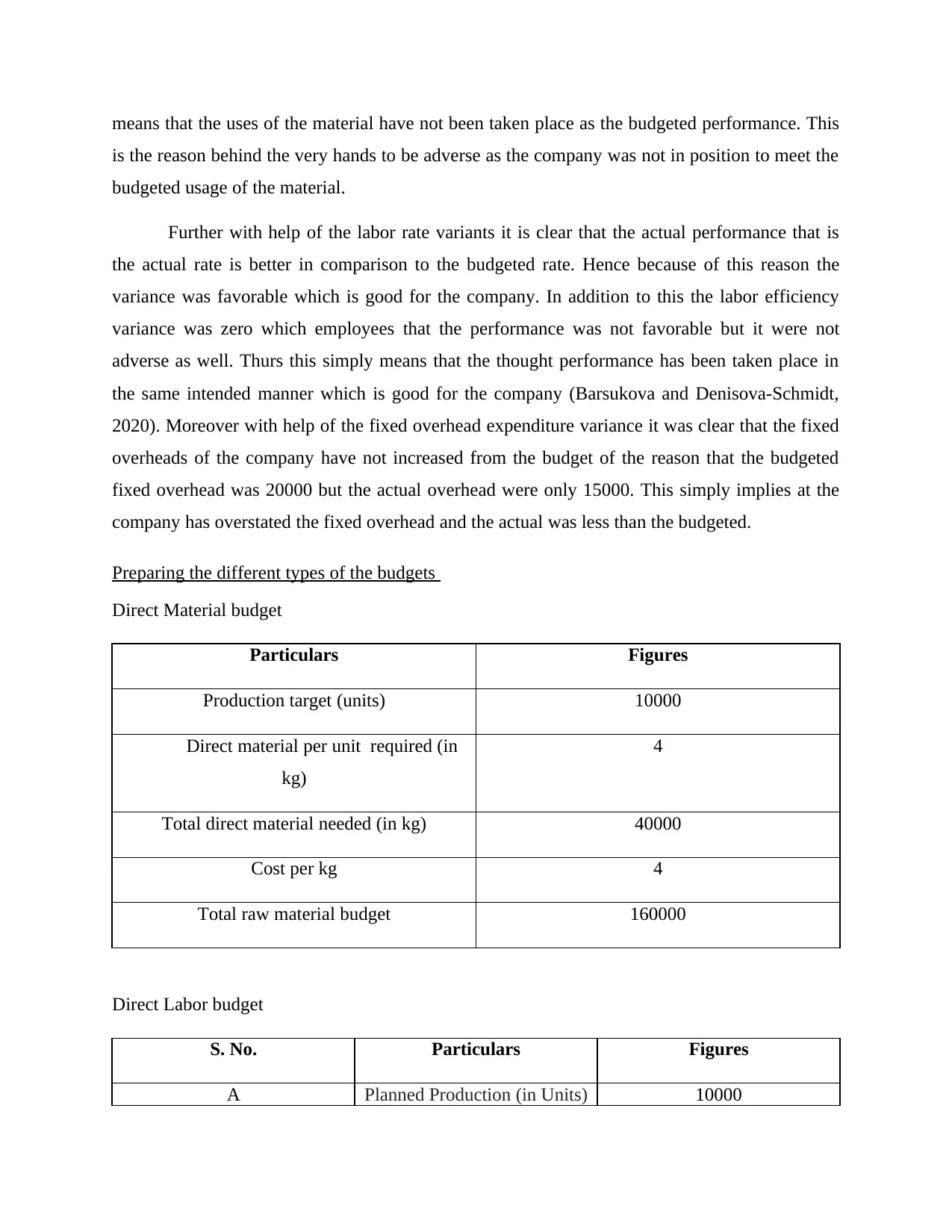
means that the uses of the material have not been taken place as the budgeted performance. This
is the reason behind the very hands to be adverse as the company was not in position to meet the
budgeted usage of the material.
Further with help of the labor rate variants it is clear that the actual performance that is
the actual rate is better in comparison to the budgeted rate. Hence because of this reason the
variance was favorable which is good for the company. In addition to this the labor efficiency
variance was zero which employees that the performance was not favorable but it were not
adverse as well. Thurs this simply means that the thought performance has been taken place in
the same intended manner which is good for the company (Barsukova and Denisova-Schmidt,
2020). Moreover with help of the fixed overhead expenditure variance it was clear that the fixed
overheads of the company have not increased from the budget of the reason that the budgeted
fixed overhead was 20000 but the actual overhead were only 15000. This simply implies at the
company has overstated the fixed overhead and the actual was less than the budgeted.
Preparing the different types of the budgets
Direct Material budget
Particulars Figures
Production target (units) 10000
Direct material per unit required (in
kg)
4
Total direct material needed (in kg) 40000
Cost per kg 4
Total raw material budget 160000
Direct Labor budget
S. No. Particulars Figures
A Planned Production (in Units) 10000
is the reason behind the very hands to be adverse as the company was not in position to meet the
budgeted usage of the material.
Further with help of the labor rate variants it is clear that the actual performance that is
the actual rate is better in comparison to the budgeted rate. Hence because of this reason the
variance was favorable which is good for the company. In addition to this the labor efficiency
variance was zero which employees that the performance was not favorable but it were not
adverse as well. Thurs this simply means that the thought performance has been taken place in
the same intended manner which is good for the company (Barsukova and Denisova-Schmidt,
2020). Moreover with help of the fixed overhead expenditure variance it was clear that the fixed
overheads of the company have not increased from the budget of the reason that the budgeted
fixed overhead was 20000 but the actual overhead were only 15000. This simply implies at the
company has overstated the fixed overhead and the actual was less than the budgeted.
Preparing the different types of the budgets
Direct Material budget
Particulars Figures
Production target (units) 10000
Direct material per unit required (in
kg)
4
Total direct material needed (in kg) 40000
Cost per kg 4
Total raw material budget 160000
Direct Labor budget
S. No. Particulars Figures
A Planned Production (in Units) 10000
Paraphrase This Document
Need a fresh take? Get an instant paraphrase of this document with our AI Paraphraser
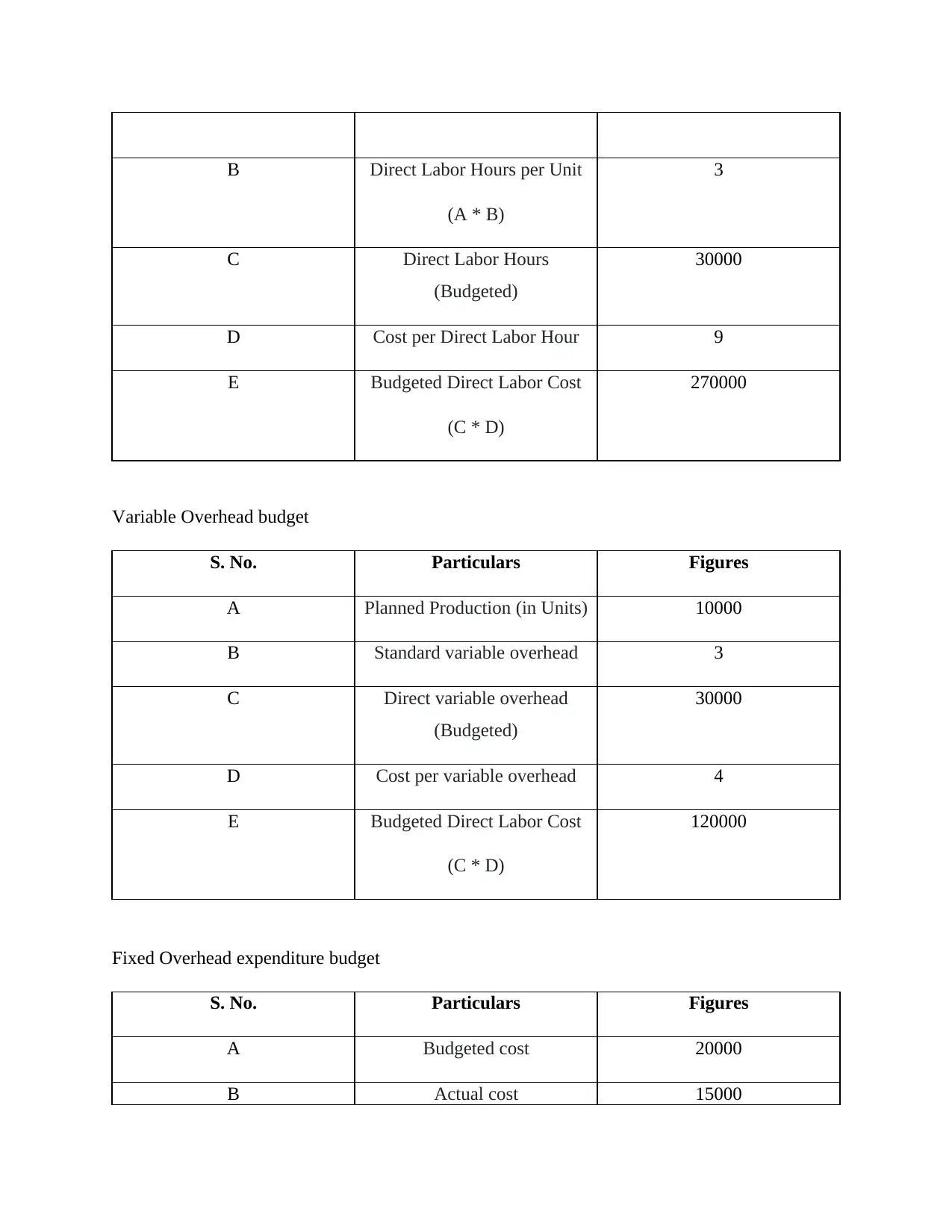
B Direct Labor Hours per Unit
(A * B)
3
C Direct Labor Hours
(Budgeted)
30000
D Cost per Direct Labor Hour 9
E Budgeted Direct Labor Cost
(C * D)
270000
Variable Overhead budget
S. No. Particulars Figures
A Planned Production (in Units) 10000
B Standard variable overhead 3
C Direct variable overhead
(Budgeted)
30000
D Cost per variable overhead 4
E Budgeted Direct Labor Cost
(C * D)
120000
Fixed Overhead expenditure budget
S. No. Particulars Figures
A Budgeted cost 20000
B Actual cost 15000
(A * B)
3
C Direct Labor Hours
(Budgeted)
30000
D Cost per Direct Labor Hour 9
E Budgeted Direct Labor Cost
(C * D)
270000
Variable Overhead budget
S. No. Particulars Figures
A Planned Production (in Units) 10000
B Standard variable overhead 3
C Direct variable overhead
(Budgeted)
30000
D Cost per variable overhead 4
E Budgeted Direct Labor Cost
(C * D)
120000
Fixed Overhead expenditure budget
S. No. Particulars Figures
A Budgeted cost 20000
B Actual cost 15000
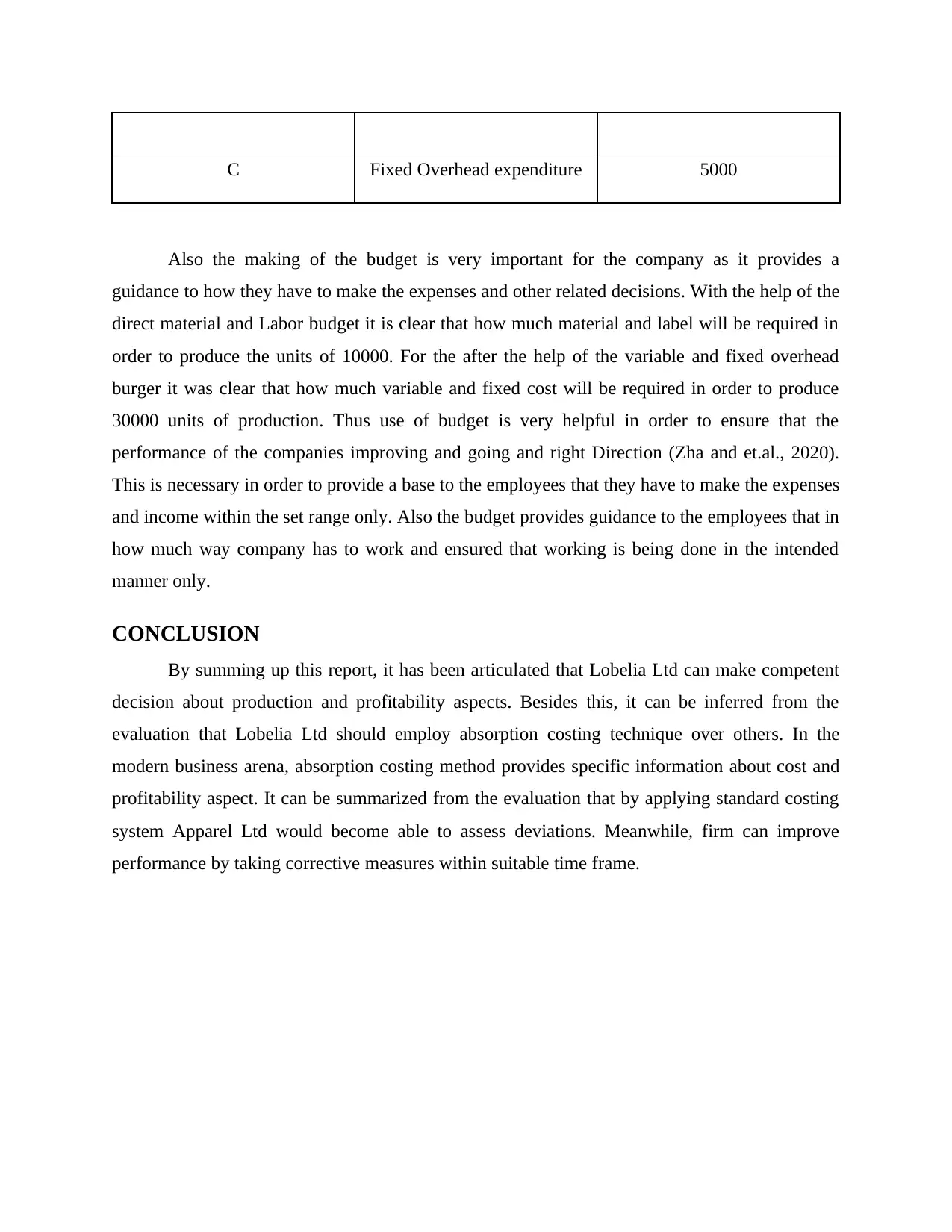
C Fixed Overhead expenditure 5000
Also the making of the budget is very important for the company as it provides a
guidance to how they have to make the expenses and other related decisions. With the help of the
direct material and Labor budget it is clear that how much material and label will be required in
order to produce the units of 10000. For the after the help of the variable and fixed overhead
burger it was clear that how much variable and fixed cost will be required in order to produce
30000 units of production. Thus use of budget is very helpful in order to ensure that the
performance of the companies improving and going and right Direction (Zha and et.al., 2020).
This is necessary in order to provide a base to the employees that they have to make the expenses
and income within the set range only. Also the budget provides guidance to the employees that in
how much way company has to work and ensured that working is being done in the intended
manner only.
CONCLUSION
By summing up this report, it has been articulated that Lobelia Ltd can make competent
decision about production and profitability aspects. Besides this, it can be inferred from the
evaluation that Lobelia Ltd should employ absorption costing technique over others. In the
modern business arena, absorption costing method provides specific information about cost and
profitability aspect. It can be summarized from the evaluation that by applying standard costing
system Apparel Ltd would become able to assess deviations. Meanwhile, firm can improve
performance by taking corrective measures within suitable time frame.
Also the making of the budget is very important for the company as it provides a
guidance to how they have to make the expenses and other related decisions. With the help of the
direct material and Labor budget it is clear that how much material and label will be required in
order to produce the units of 10000. For the after the help of the variable and fixed overhead
burger it was clear that how much variable and fixed cost will be required in order to produce
30000 units of production. Thus use of budget is very helpful in order to ensure that the
performance of the companies improving and going and right Direction (Zha and et.al., 2020).
This is necessary in order to provide a base to the employees that they have to make the expenses
and income within the set range only. Also the budget provides guidance to the employees that in
how much way company has to work and ensured that working is being done in the intended
manner only.
CONCLUSION
By summing up this report, it has been articulated that Lobelia Ltd can make competent
decision about production and profitability aspects. Besides this, it can be inferred from the
evaluation that Lobelia Ltd should employ absorption costing technique over others. In the
modern business arena, absorption costing method provides specific information about cost and
profitability aspect. It can be summarized from the evaluation that by applying standard costing
system Apparel Ltd would become able to assess deviations. Meanwhile, firm can improve
performance by taking corrective measures within suitable time frame.
⊘ This is a preview!⊘
Do you want full access?
Subscribe today to unlock all pages.

Trusted by 1+ million students worldwide
1 out of 13
Related Documents
Your All-in-One AI-Powered Toolkit for Academic Success.
+13062052269
info@desklib.com
Available 24*7 on WhatsApp / Email
![[object Object]](/_next/static/media/star-bottom.7253800d.svg)
Unlock your academic potential
Copyright © 2020–2026 A2Z Services. All Rights Reserved. Developed and managed by ZUCOL.





